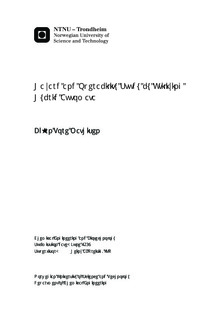Hazard and Operability Study by Utilizing Hybrid Automata
Master thesis
Permanent lenke
http://hdl.handle.net/11250/2351771Utgivelsesdato
2014Metadata
Vis full innførselSamlinger
Sammendrag
The following thesis is the end of a five year master program at the Norwegian University of Science and Technology, as part of the process eng. group at the institute of chemical engineering. Supervisor for the thesis has been professor Heinz Preisig, who also contributes directly as the thesis revolves around an algorithm developed during P. Philips Phd research period \cite{patphd} in 2001, with Preisig as a supervisor. In addition his graphical approach to modelling of continuous systems has also served as a large inspiration in this thesis. His continuous support, encouragement and open door policy has been greatly appreciated.
This thesis utilizes the hybrid automaton modelling procedure. A modelling technique designed for dealing with hybrid systems. Hybrid systems are systems with mixed discrete and continuous dynamics. A description fitting a large number of systems, i.e. a digital signal affecting a system with continuous natural behavior. This makes the technique highly applicable in chemical engineering. All modelling of process systems is affected by the person responsible, in term of assumptions and simplifications. In this thesis a three tank system is modelled as a hybrid automaton by discretizing the continuous state space into a set of hypercubes. By doing so a large number of possible state trajectories can be evaluated crudely by considering the predetermined directionality of the transition between hypercubes.
By utilizing the algorithm developed by \citet{patphd} a hybrid automaton with a table of possible state transitions is returned. The transition tables displays the directionality of the state in question in regard to a dependable state. By defining a hazardous boundary, i.e. highest allowed temperature, any state reaching a hazardous value can be identified by a transition direction to the hazardous region. Two hypothesis was suggested and evaluated by implementing the algorithm in a case study. The hypothesis was tested by comparing the hazards identified by searching the transition tables to a conventional structurized hazard and operability study. The two hypothesises were:
Hypothesis 1: Any guideword/parameter combination in a conventional hazard and operability study can be swapped with an evaluation of the hybrid automaton transition table
Hypothesis 2:If the automaton is generated over the boundaries spanning the safe operation domain. Any operational hazards must be visible in the transition table as a possible transition out of the domain
The case study was a three tank hot and cold liquid mixing plant. The system has a total of 6 states, leading to 6 transition tables. A search algorithm was developed to identify possible hazards. The algorithm successfully identified hazardous transitions for the case study, and the hazards match the results form manual evaluation.
After a comparison between the conventional hazard and operability study and the hybrid automaton approach the hypothesis still stands. However, there is some uncertainty whether the discrete input used by the hybrid automaton, e.g., flow rates being set to max or min, is sufficient for more complex systems. For example, it is well-known that maximum temperature out of exothermic reactors may occur at flow-rates between max and min due to non-linear effects.
In order to apply the algorithm on industrial plants, capabilities to detect and handle completely independent states must be improved. A state variable transfer from enthalpy to temperature resulted in a software crash due to independent states. Such independency will be normal in real plants. Disregarding independent states completely is not beneficial since other states may depend on said state, and this makes it vital to include in the hybrid automaton.
